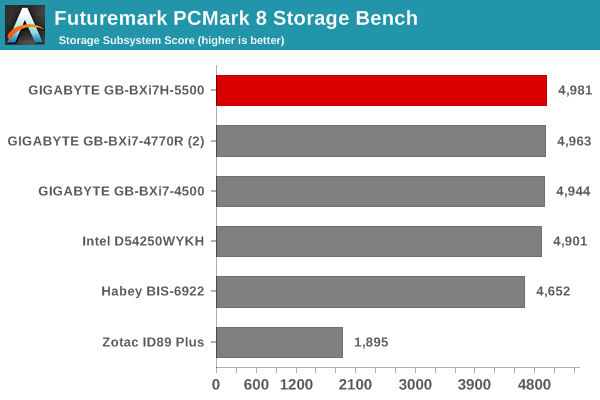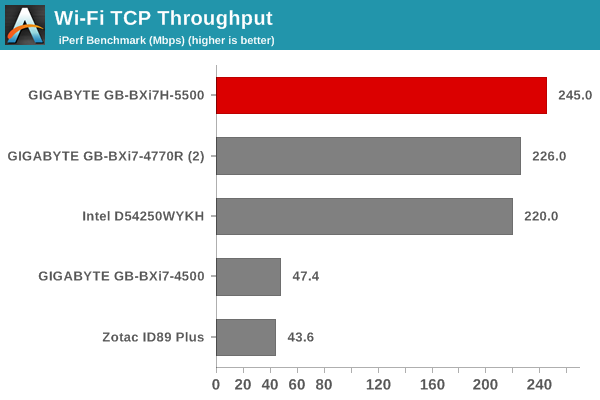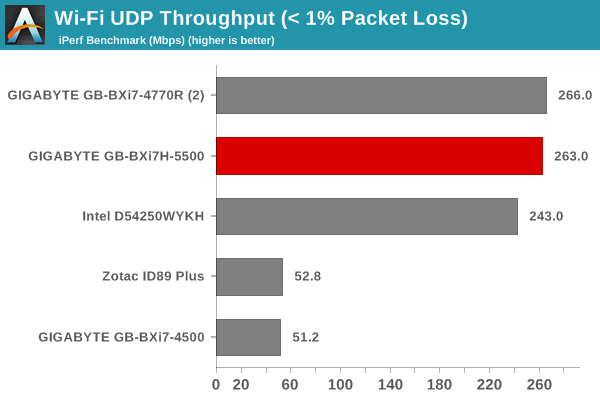GIGABYTE GB-BXi7H-5500 Broadwell BRIX Review
by Ganesh T S on January 29, 2015 7:00 AM ESTNetworking and Storage Performance
We have recently started devoting a separate section to analyze the storage and networking credentials of the units under review. On the storage side, one option would be repetition of our strenuous SSD review tests on the drive(s) in the PC. Fortunately, to avoid that overkill, PCMark 8 has a storage bench where certain common workloads such as loading games and document processing are replayed on the target drive. Results are presented in two forms, one being a benchmark number and the other, a bandwidth figure. We ran the PCMark 8 storage bench on selected PCs and the results are presented below.


Surprisingly, the combination of the Core i7-4500U and Samsung's SSD 840 EVO delivers best-in-class results. The same SSD (albeit, with an earlier firmware version) benchmarked lower even in the BRIX Pro. Of course, the SSD 840 EVO is having trouble with the old data read speeds issue - The above results are not recommending the 840 EVO in any way, but just presenting what a fresh SSD 840 EVO can achieve in conjunction with the GB-BXi7H-5500.
On the networking side, we restricted ourselves to the evaluation of the WLAN component. Our standard test router is the Netgear R7000 Nighthawk configured with both 2.4 GHz and 5 GHz networks. The router is placed approximately 20 ft. away, separated by a drywall (as in a typical US building). A wired client (Zotac ID89-Plus) is connected to the R7000 and serves as one endpoint for iPerf evaluation. The PC under test is made to connect to either the 5 GHz (preferred) or 2.4 GHz SSID and iPerf tests are conducted for both TCP and UDP transfers. It is ensured that the PC under test is the only wireless client for the Netgear R7000. We evaluate total throughput for up to 32 simultaneous TCP connections using iPerf and present the highest number in the graph below.

In the UDP case, we try to transfer data at the highest rate possible for which we get less than 1% packet loss.

The WLAN performance is good, considering that the Intel AC3160 is a 1x1 802.11ac solution with a maximum theoretical bandwidth of 433 Mbps. We are quite happy to see GIGABYTE discarding the Realtek 802.11ac solution. That said, the use of an Intel AC7260 or AC7265 2x2 solution or a Broadcom BCM4352-based WLAN card would have been even better. On the wired networking side, it is disappointing to see GIGABYTE avoid an Intel GbE LAN chipset such as the i217-V. Instead, we have a Realtek chipset (which doesn't offload the CPU as much as the Intel i21x when it comes to processing network traffic).










53 Comments
View All Comments
jaydee - Thursday, January 29, 2015 - link
I was hoping for a bit more here from Intel. Looking at the encoding, compressing, encrypting benchmarks, almost nothing was gained performance-wise, or in terms of power consumption.Flunk - Thursday, January 29, 2015 - link
Broadwell is an incremental update so it's not a big surprise.gonchuki - Thursday, January 29, 2015 - link
Doesn't even look incremental, more like a step revision of Haswell (just a node shrink and nothing else). It's the same processor Intel launched in 2013, but on a 14nm node.Refuge - Thursday, January 29, 2015 - link
Tick Tock Tick Tock.Although I've noticed their "Tick Tock" Has been slightly off cadence since their "Mobile First" strategy.
quophog - Friday, January 30, 2015 - link
No surprise really. No competition at all at the performance end. All their effort is going in to the ultra low power & cost end where ARM based architectures currently dominate. Very sad for everyone (except intel share holders) that AMD couldn't keep up with Intel R&D and fab spending.It's a long way off anyway, but I really hope Intel fab advantage doesn't let them eventually monopolise mobile procs too..
Haravikk - Friday, January 30, 2015 - link
Is that really such a bad thing? Making a smaller, much more power efficient processor without sacrificing any performance is still a pretty big accomplishment. While it might not make existing machines much more exiting, the really interesting part is what new things it makes possible.It's for this reason I hate this new Brix machine; it's the same horrific chassis as before, the with the same anaemic cooling. It should be possible for this to be entirely passively cooled, particularly if they want for a smaller, flatter, aluminium design.
eanazag - Friday, January 30, 2015 - link
Intel has done well, but with a competitive AMD we get better prices and more features. ARM has kept Intel moving, but look at the server market. Prices run from $200+ - north of $2000 for 2P systems. And Intel has the middle filled out too. Intel is charging whatever the hell they want there.eanazag - Friday, January 30, 2015 - link
It does look incremental in some benches. In others it is on par. For this type of system I would be leaning towards the 4770R. I don't care for the gaming performance on the 5500U. It is fine at 1280x1024/1366x768. I'd rather have the option to take a step up. The 4770R can do decent in 1600x900/1600x1000. For $750+ I'd like to be doing better. Broadwell Iris Pro may be what I'm hoping for.Otherwise, I'm a 5500U with a mobile GPU built-in - pricing and features may see which way I lean. I'm not a HTPC user.
nathanddrews - Thursday, January 29, 2015 - link
I don't think we should jump to judgment based upon multiple platforms with vastly different components. The closest competitor in this review is the 4500U, which the 5500U decimates in half the benchmarks, while leading it by at least a small margin in the rest. I'm looking forward to a more controlled, thorough review of Broadwell.I know that the gaming tests are set in stone and you try not to change them, but can we please drop the 1280x1024 test and replace it with 1280x720? It's 30% less taxing for these weak GPUs and is much more likely to be used by gamers - either on HDTVs, notebook displays (768p), and widescreen monitors. Nearly all 360/PS3 games are 720p, so many people are comfortable with that resolution and it scales to 1080p, 1440p, and 4K. It's just more realistic. No one games at 1280x1024 anymore unless they like pillarboxing and letterboxing at the same time. 720p and 1080p are really the only meaningful resolutions for these GPUs. You can save yourself some time, too...
ATC9001 - Thursday, January 29, 2015 - link
+1 for 720p resolution. If possible atleast add this to existing HTPC benchmarking, and of course when the benchmark is revamped for it's next iteraion, drop 1280x1024 completely!